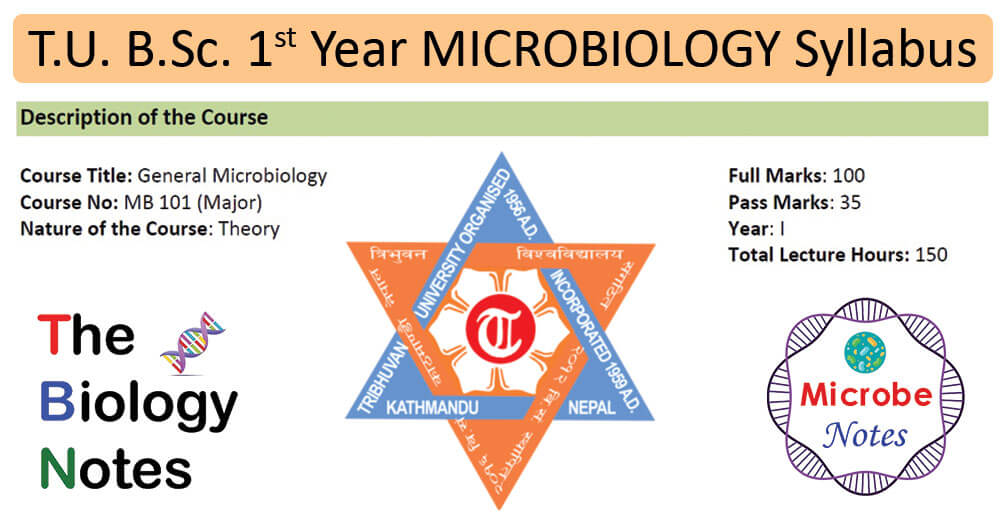
Description of the Course
Course Title: General Microbiology
Course No: MB 101 (Major)
Nature of the Course: Theory
Full Marks: 100
Pass Marks: 35
Year: I
Total Lecture Hours: 150
Course Objectives
After completion of the course, the students will be able to:
a) understand the concept of microorganisms, history of microbiology, classification schemes and the nomenclature of microorganisms, scope, and applications of microbiology
b) know handling methods, growth, physiology, metabolism, genetics of microorganisms
c) understand the basics of bacteriology, virology, mycology, and parasitology
Course Contents
History and development of microbiology– 4hrs
Development of microbiology with reference to the modern era, important discoveries,theories of spontaneous generationandthe germ theory of disease(Louis Pasteur,Robert Koch)
Classification and nomenclature of microorganisms- 15hrs
Classification schemes of a living organism, differential characteristics of prokaryotic and eukaryotic microorganism. The general principle of nomenclature,threeandfive-kingdomconcepts, a basic understanding of theclassification of bacteria,viruses,fungiandprotozoa, classification, nomenclature and characterization of bacteria according toBergey’s Manual of Systematic Bacteriology
Scope and applications of microbiology– 7hrs
Harmful and beneficial microorganism; applied microbiology (medical, public health, agricultural, food, microbial biotechnology, environmental, industrial, pharmaceutical microbiology)
Morphology of bacteria– 10hrs
Structure of bacteria, morphology and fine structure of cell organelles,differences between gram-negative and gram-positive bacteria
Growth and physiology of bacteria- 8hrs
Nutritional types of bacteria(photolithotrophic, chemolithotrophic, photoorganotrophic, chemoorganotrophic), entry of nutrients,passiveandactive transport,bacterial growth,growth curve,factors affecting the growth
Isolation, enumeration, and culture of bacteria- 10hrs
Types of bacteriological culture medium, techniques for isolation and enumeration of bacteria (streak plate technique,pour plate technique,spread plate technique,membrane filtration,most probable number method,direct microscopic count),biochemical tests of bacteria, methods of the culture of aerobic and anaerobic bacteria,culture preservation methods
Metabolism- 15hrs
Introduction to metabolism, regulation, and energy involved inglycolysis (Embden Mayerhoff Paranas pathway),glycogenesis,glycogenolysis,TCA cycle,pentose phosphate pathway, Entner Doudoroff’s pathway,phosphoketolase pathway, fermentative pathways, andelectron transport system
Microbial genetics- 15hrs
Structure and function of prokaryotic DNA,genetic code, plasmids, concepts of bacterial genetics and role of RNA & DNA; bacterial recombination (transformation, conjugation, and transduction),typesandimportance of mutation
Microscopy and different techniques of handling of microorganisms- 8hrs
Microscopes(light, stereo,darkfield,phase contrast,electron,fluorescence),types of stainingand nature of dyes/stains,different types of staining methods for microorganisms,aseptic techniques in microbiology
Techniques in control of microorganisms 12hrs
disinfe的原则、程序和应用ction and sterilization-temperature, irradiation, ultrasonication, filtration, chemicals, antibiotics, and chemotherapeutic agents
主机,parasite interaction10hrs
Normal microbial flora of the human body,the concept of host-parasite relationship,the concept of immunity
Introduction to virology- 12hrs
General structure (size, symmetry, and shape) of the virus,classification schemes, viral genetics, detection, enumeration (plaque assay, haemagglutination test,quantitative PCR,neutralization test),cultivation of viruses
Introduction to parasitology- 12hrs
Origin, morphology and classification of parasites (blood, tissue, intestinal parasites, soil-transmitted helminths, and nematodes), techniques of detection, enumeration and identification of protozoan and helminthic parasites
Introduction to mycology- 12hrs
Origin,morphology, andmedical classification of fungi. Techniques of isolation, morphological identification, culture, and enumeration ofyeast and mold
Recommended Readings
Textbooks
1. Collins CH, Patricia M, and Lyne JM (1995). Collins and Lynes Microbiological Methods 7th edition. Grange, Butter Worth, Oxford.
2. Cappucino JG and Sherman N (1996). Microbiology, A Laboratory Manual 4th edition. Benjamin Cumings Inc. California.
3. Pelczar MJ, Chan ECS and Krieg NR (1993). Microbiology 5th edition, Tata McGraw Hill.
4. Madigan MT, Martinko JM and Parker J (2012). Brock Biology of Microorganism, 11th edition Prentice Hall International Inc. London.
Reference books
1. Atlas RN (1984). Microbiology: Fundamental and Applications. Memillan Co.
2. Greenwood D, Richard CD, John S and Peuther F (1992). Medical Microbiology, 16th edition. ELBS, Churchill living stone.
References
Tribhuvan University.Institute of Science and Technology. 4 year’s Bachelors of Science Revised Course of Study. Dean’s Office, Kirtipur, Kathmandu, Nepal.

